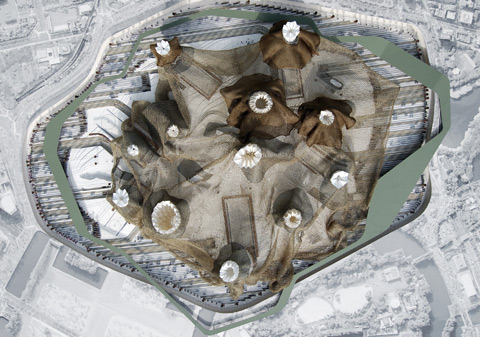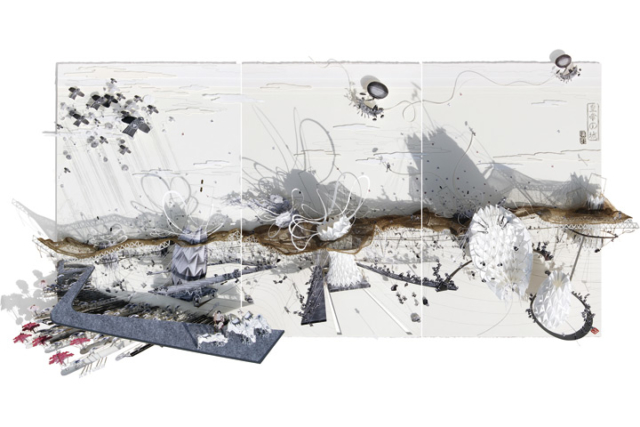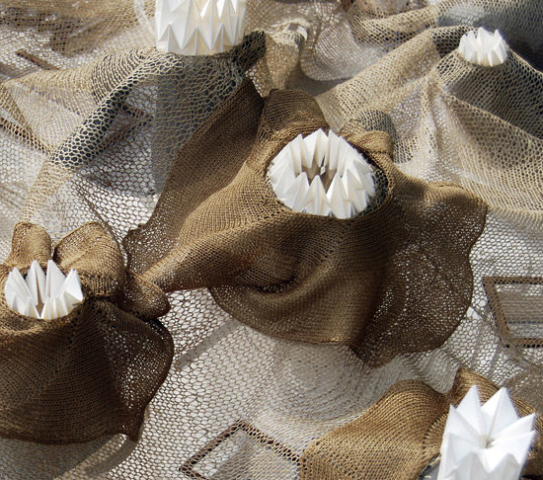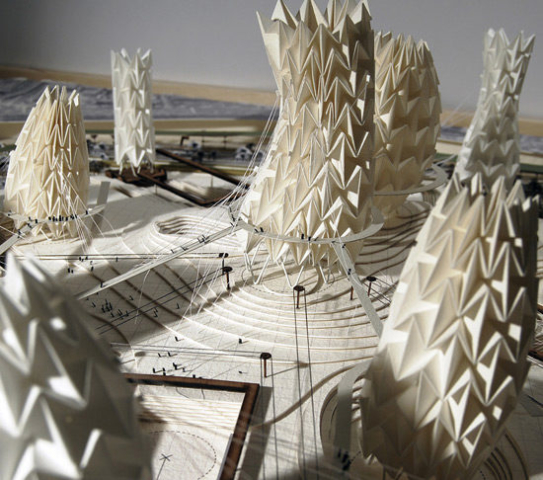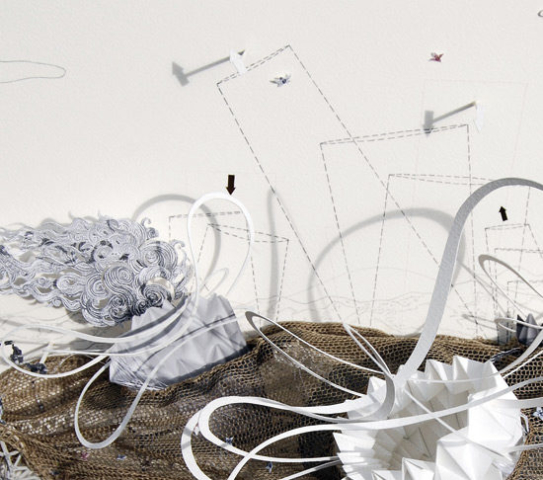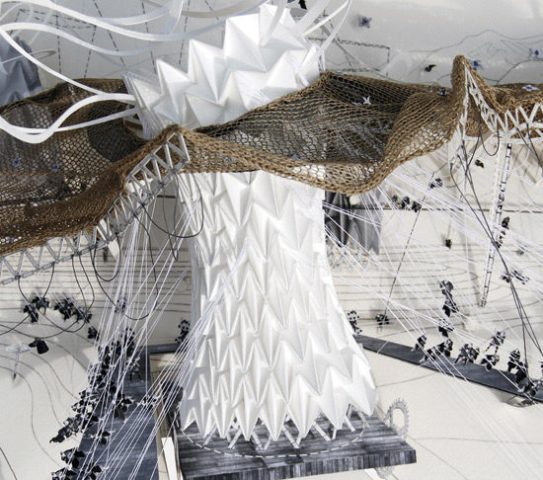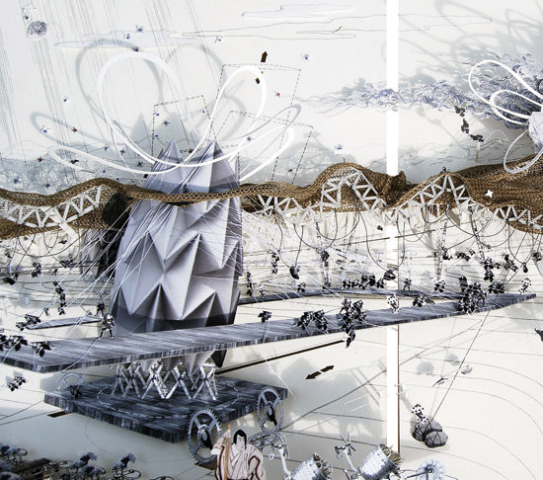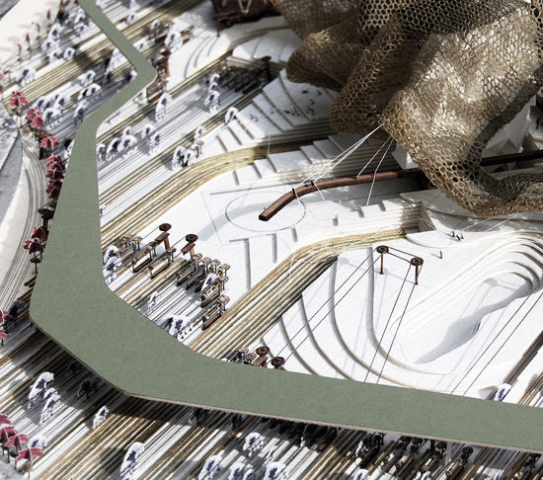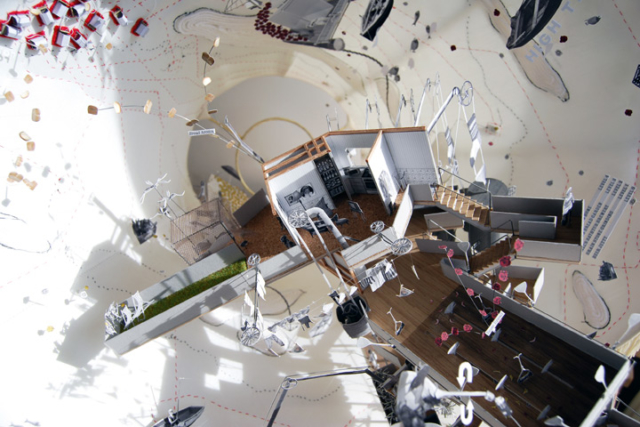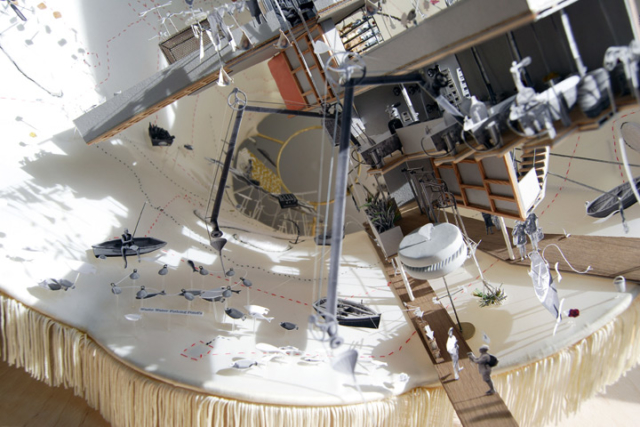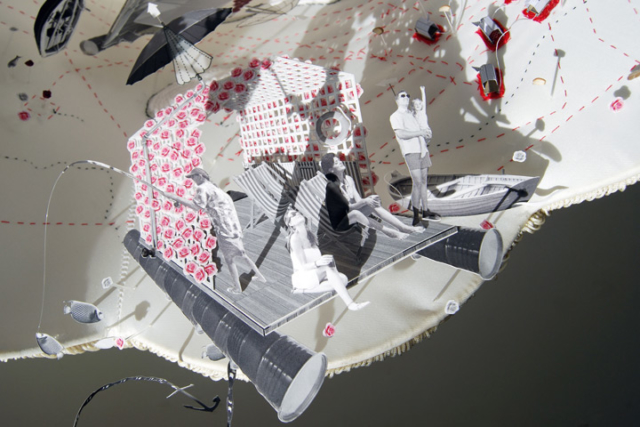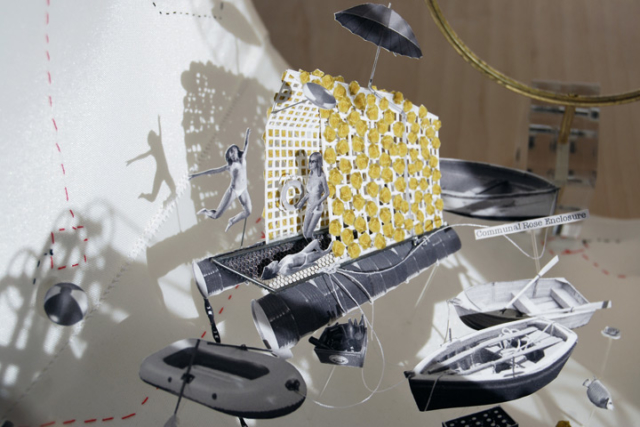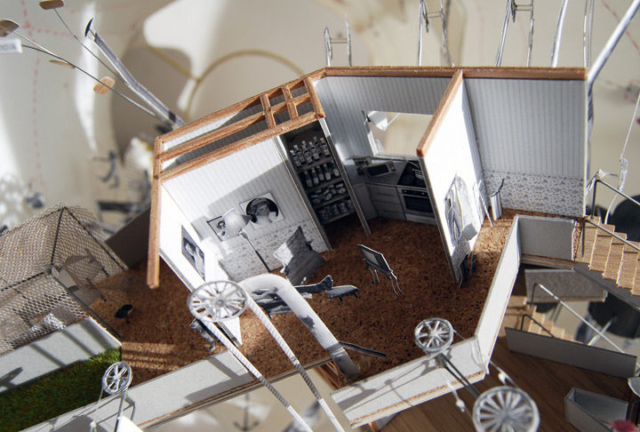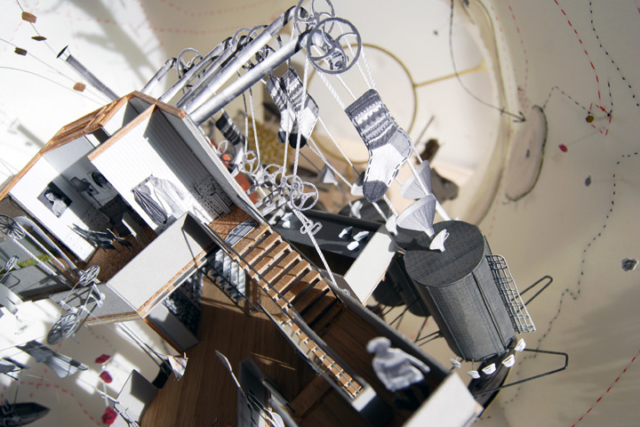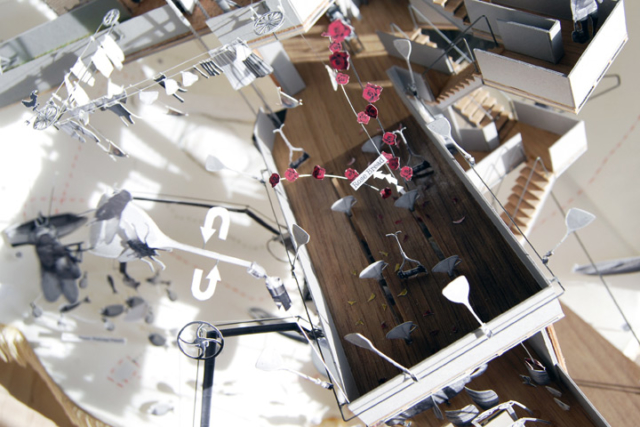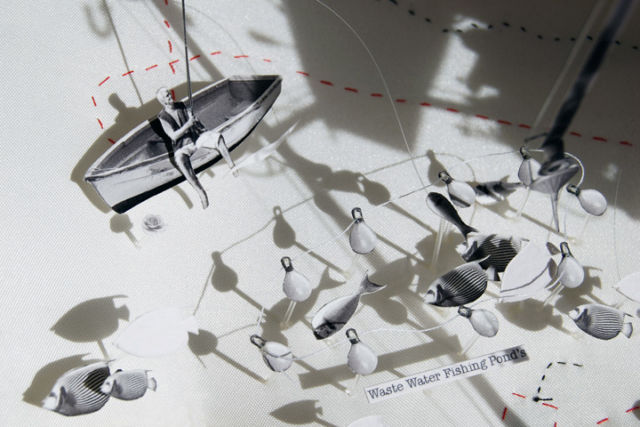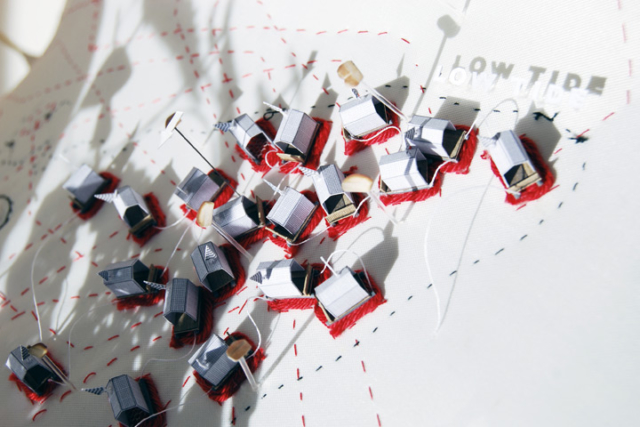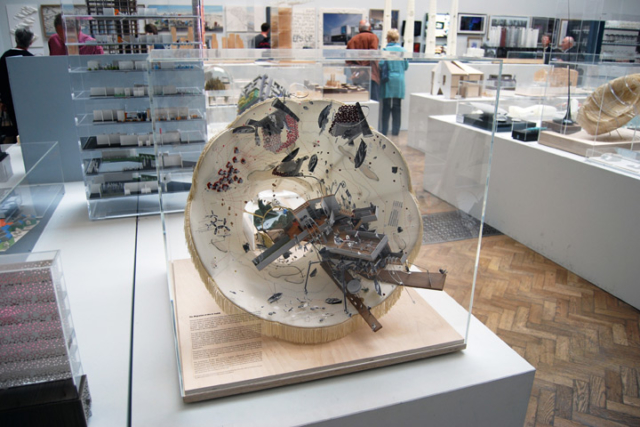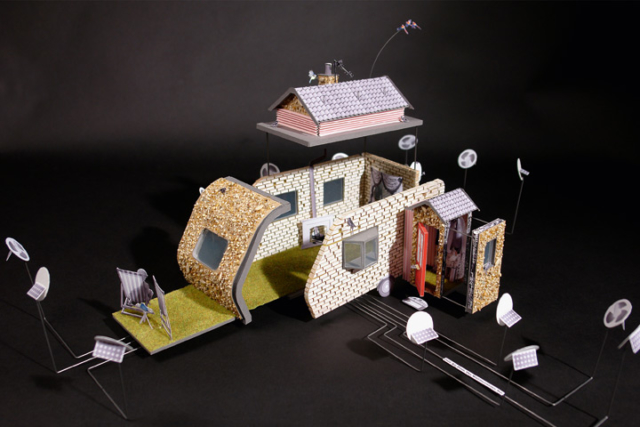Thomas Hillier
www.thomashillier.co.uk
Tomas Hilier je rođen i odrastao u okrugu Dorset. Godine 2001., počeo je da studira dizajniranje nameštaja na Ravensborn Koledžu u Londonu, ali je nakon godinu dana shvatio da mu arhitektura više odgovara upisao je i diplomirao 2004-te godine. Nakon toga je stekao još jednu diplomu iz oblasti arhitekture u Bartlet školi Arhitekture kod profesora CJ Lima i Bernda Felsingera.
2008.godine Tomas je osvojio Odlikovanje za dizajn za svoj projekat “Carev zamak” u kome koristi pripovedanje kao sredstvo za ispitivanje savremenih kulturnih i društvenih pitanja u Tokiju i Japanu. Za ovaj projekat je takođe osvojio nagradu za najbolji dizajn u okviru Bartlet Diplome i bio je kandidovan za najboljeg diplomiranog studenta za godišnju nagradu BD magazina.
Njegov rad mu je doneo veliki broj nagrada i priznanja, a takođe je objavljivan u mnogim časopisima (Icon, Blueprint, Domus), a nedavno je objavljen i kao deo projekta “Bartlet Dizajn- Spekulisanje sa arhitekturom”. Njegovi radovi su izlagani širom sveta, a prošle i tekuće godine su bili veoma zapaženi na Letnjoj Izložbi Kraljevske Akademije, i tom prilikom je osvojio nagradu za najboljeg premijernog umetnika. Tomas i njegov projekat “Selidba Mela i Džudit” predstavljeni su u kulturnom programu Kraljevske Akademije BBC televizije, u kojoj je pričao o kreativnom procesu koji se odvijao u pozadini “Abažura”. Tomas je nedavno pobedio na RMIT otvorenom konkursu “PlastiCity-FantastiCity” u Melburnu.
Njegova zainteresovanost za arhitekturu ide dalje od same gradnje i uključuje umetnost, dizajn, pripovedanje i instalacije sa posebnim osvrtom na objašnjenje kako književnost može da bude direktno prevedena u urbani i arhitektonski prostor. On teži da arhitekturu posmatra sa drugačijeg aspekta, koristeći neobično pripovedanje i programe da bi stvorio originalna i često nadrealna zapažanja. Ova zapažanja koriste inovativne i poetske materijale u kombinaciji sa tehnološkim i ekološkim razumevanjem da prošire granice prostornog dizajna. Pokreće ga detaljno određen način rada koji je ilustrovan kroz crteže, modele i montaže. Ono što je najvažnije, on se trudi da ne shvata preozbiljno arhitekturu i pokušava da u svoje ozbiljne radove ubaci trunčicu humora jer smatra da je mišljenje,- da arhitektura ne može da bude zabavna, pogrešno.
Emperor’s castle
Carev zamak potiče iz mitske priče sakrivene u pejzažnoj sceni u duborezu koju je oslikao grafički tehničar Ando Hiroshige, polaznik japanske škole slikanja Ukiyo-e. Priča govori o dvoje ljubavnika, Princezi i Pastiru čijoj ljubavi je na put stao njen otac Car. Ovi likovi su bili zamenjeni arhitektonskim metaforama stvarajući urbano pozorište unutar osnove Carske Palate u Tokiju.
Traženje, proučavanje ili čak stvaranje ove narativne mitologije otvara svet bezgraničnih istraživanja, bezgraničnih gradova sa jedinstvenim identitetom, gde vam granicu može postaviti samo sopstvena mašta. Ispod se nalazi moj grad, grad koji je i više od običnog grada; to je svet pripovedanja koji ilustruje kako književnost može direktno da bude prevedena u urbani arhitektonski prostor.
Slike 1 i 2 su dva akta iz serije od ukupno 5 slika, koje ilustruju i istražuju pripovedačku strukturu priče da bi stvorile niz tragova koji pružaju informacije za buduće arhitektonske projekte. Ovi ručno pravljeni papirni kolaži, sečeni su direktno u album, stvarajući knjigu u 2.5D grafičkoj projekciji.
Slika 1, pod nazivom Akt 3- Večna kazna, prikazuje carev bes zbog veze njegove kćerke i pastira. On razdvaja par i premešta ih na njihove prvobitne lokacije. Car je želeo da bude siguran da se oni nikada ponovo neće sresti, pa je zatvorio zamak i otvorio nebesa. Pala je velika kiša i potopila odbrambeni rov zamka, stvarajući od njega ostrvo okruženo dubokim i brzim jezerom koje nijedan čovek nije mogao da prepliva. Od tada na ovom području stalno pada kiša.
Slika 2, pod nazivom Akt 5- Poslednji sastanak. Kada su videli tugu njihove prijateljice Princeze, ptice i životinje su se okupile da osmisle kako da zaustave bujicu njenih suza. Nebo je postalo crno kada su sve svrake i vrane, raširivši svoja krila, napravile most preko jezera. Kada je Princeza shvatila šta su ptice uradile, prestala je da plače i požurila preko pernatog mosta da zagrli Pastira i da obnove zavet na večnu ljubav.
Slike 3-5 su ručno sečeni papirni kolaži koji predstavljaju tranziciju arhitektonskih karaktera kroz koji se likovi iz priče transformišu u delove arhitekture.
Slika 4- Princezin pleteni prekrivač- Princeza koju predstavlja fleksibilna, prozračna, pletena membrana obmotava donji prostor, a proizvedena je od “Igusa”, materijala koji se koristi u proizvodnji tatami strunjača. Dok se koža njiše, Igusa ispušta umirujući miris za koji se smatra da opušta telo i um. Ovaj miris budi sećanja na Pastira i širi se nad gradom, smirujući um njegovih stanovnika.
Slika 5- Pastirova Mehanička Kosilica u obliku krave- Pastir je arhitektonski predstavljen kao travnati pojas koji prekriva područje, obuhvatajući Careva pluća i Princezinu pletenu kožu. Oličenje pastira su mehaničke krave koje služe kao kosilice za travu koje lutaju pašnjakom, koseći travu i šireći miris ka Princezi da je podseća na Pastira.
Slika 6- Konačni model u svom Tokio kontekstu.
Slika 7- Careva origami pluća
Slika 8- Plućni pokreti stvaraju vazduh koji je usmeren naviše čineći da kragne oko pluća lepršaju, vizuelno povećavajući uticaj carevog besa.
Slika 9- Pastirov travnjak je park koji javnost koristi da bi posmatrala spektakl. Ovo područje se nalazi iznad “Potemkin” mehaničkih talasa koji predstavljaju duboko i brzo jezero. Ovi talasi se smenjuju sa “Igusa” livadama koje su isečene i poslate Princezi za pletivo.
Slike 10-14- Konačni triptih, presek kroz urbani teatar ilustruje frenetičan “život” objekta. Ovaj 1.8m x 0.8m komad je kulminacija svih gore opisanih istraživanja i dizajnerskih sinteza.
Cilj Carevog zamka bio je da izazove razmišljanje, a nikada da širi ili pokušava da reši sve svetske probleme.
Migration of mel & judith
SELIDBA MELA I DŽUDIT- EPIZODA 1, EVROPA:
“Selidba Mela i Džudit” je bila preteča “Carevog zamka” i moje prvo, pravo istraživanje upotrebe pripovedanja kao sredstva za uobličavanje i kontrolisanje mojih arhitektonskih ideja. To je takođe bio i period u kome sam počeo da koristim 2/3 dimenzionalnu montažu da bih ilustrovao dizajnerski proces.
Ovaj projekat je podeljen u dve geografske epizode i istražuje život i putovanje engleskog bračnog para Mela (skraćeno od Melvin) i njegove supruge Džudit. Nedavno penzionisani par je odlučio da napusti svoj život u Londonu i putuje po Evropi u potrazi za savršenim mestom za svoj karavan i za toplim vremenom. Tokom putovanja shvatili su da im nedostaje udobnost njihove kuće u Engleskoj, a posebno beli hleb koji nisu mogli da pronađu u inostranstvu. Da bi ublažili žudnju, lagano su počeli da adapitraju i preuređuju svoju karavan kućicu da bi ih što više podsećala na dom. Zidovi karavana su izgrađeni od aromatizovanih “cigli” belog hleba, koje su sami Mel i Džudit napravili.
Druge adaptacije uključuju omalterisanu fasadu koja podseća na fasadu njihove kuće u Krojdonu, a napravljena je od komadića hleba koje je izabrao Mel (to su mrvice koje su se zaglavile u njegovoj protezi). Tepih od zelene trave je pod nogama mnogo hladniji od vrelog peska Marbelje, a veliki broj ventilatora na solarno napajanje koji okružuju karavan kućicu definiše Melovu i Džuditinu teritoriju gde god bi postavili kamp. Ovi ventilatori stvaraju mikroklimu između toplog vazduha Marbelje i hladnog vazduha karavan kućice. Ipak, ako im bude previše vruće, ponovo mogu da stvore englesku klimu koristeći krovni sistem za prskanje ili mašinu za sneg u kaminu.
Ovaj deo projekta sadrži Melova i Džuditina sećanja o stvaranju njihovog putujućeg hleb-karavana, što je metafora za premeštanje iz jedne kulture u drugu.
SELIDBA MELA I DŽUDIT- EPIZODA 2, LUKSOR:
Pošto im je u Evropi postalo dosadno, Mel I Džudit su odlučili da započnu novi život u Luksoru, u Egiptu (Džudit obožava Agatu Kristi). Oni sada žive na malom, nenaseljenom ostrvu na reci Nil, gde na njihov čudan I zadivljujući “Uradi Sam” engleski način Mel proizvodi pivo u svojoj kadi, a Džudit peče ružin hleb u hleb-bašti.
Između septembra i marta, Melova i Džuditina kolibica miruje, omogućavajući paru priželjkivan odmor i pružajući Melu priliku da pravi svoje pivo. Od aprila do avgusta (letnja sezona u Egiptu) Nil nadolazi i ostrvo je potopljeno i samo su visoki izdanci dostupni. Na najvišem od ovih izdanaka nalazi se Melov i Džuditin dom, koji su sopstvenim rukama gradili, oblikovali i dograđivali. To je sada pivara, pekara, mesto za odmor i udobno utočište za gledanje omiljene TV serije.
Ostrvo oživljava tokom letnje sezone stvarajući englesku bazu u sred Luksora, koja mami engleske turiste mogućnošću da budu okruženi znamenitostima i mirisom doma. Za mnoge je nemoguće odoleti mirisu ruža, svežeg, pečenog hleba, kao i iskušenju da se proba pivo koje je inače zabranjeno u Luksoru.
Ova druga epizoda se interno i eksterno odvija na kičastom abažuru iz sedamdesetih godina prošlog veka koji poseduju Mel i Džudit, kao i još mnoge deke i bake (uključujući i moje). Spoljašnjost abažura istražuje u najsitnijoj razmeri priču i pokrete ružičaste kolibe tokom leta kada je plima Nila na svom vrhuncu. Unutrašnjost abažura puca od života, istražujući Melovu i Džuditinu kuću i kako njihove aktivnosti utiču na Nil i šire.
Arhitektura je kreirana I izgrađena za specifične potrebe I funkcionisanje dvoje korisnika, a ne radi estetike. Projekat ima za cilj da bude lep u svojoj ružnoći, sa održivim životnim ciklusom koji omogućava Melu I Džudit da “žive od zemlje”. On nije zainteresovan za modernu održivost koja je, čini se, više povezana sa tehnološkim napretkom nego sa uticajem na životnu sredinu. Objekat podseća na prošla vremena I sistem”uradi sam” koji je bio zastupljen u TV seriji iz sedamdesetih godina dvadesetog veka, koja govori o penzionisanom paru koji je odlučio da živi održiv, jednostavan I samodovoljan život u svojoj dragoj kućici.
Tako da, ako se ikada zadesite u Luksoru I uželite se doma, otplovite čamcem do Melovog I Džuditinog ostrva da osetite malo parče Engleske…jer znate kako se kaže: ”nema mesta kao što je dom”.
1. Počinje Melovi i Džuditino putovanje!
Nedavno penzionisani engleski bračni par Mel (skraćeno od Melvin) i njegova supruga Džudit odlučili su da napuste svoj život u Londonu i putuju po Evropi u potrazi za savršenim mestom za svoj karavan i za toplim vremenom.
2. Hlebni karavan
Tokom putovanja par je shvatio d aim nedostaje udobnost njihove kuće u Engleskoj, a posebno beli hleb koji nisu mogli da pronađu u inostranstvu. Da bi ublažili žudnju, lagano su počeli da adapitraju i preuređuju svoju karavan kućicu da bi ih što više podsećala na dom.
3. Proces zidanja hlebom
Zidovi karavana su izgrađeni od aromatizovanih “cigli” belog hleba, koje su sami Mel i Džudit napravili.
4. Omalterisan trem
5. Omalterisana nadstrešnica
Omalterisana fasada podseća na fasadu njihove kuće u Krojdonu, a napravljena je od komadića hleba koje je izabrao Mel (to su mrvice koje su se zaglavile u njegovoj protezi).
6/7. Selidba Mel i Džudit izložena je u Kraljevskoj Akademiji u Londonu 2010.godine
8. Ružičasta koliba- Plima
Ružičasta koliba plovi rekom Nil, spuštajući sidro kad god to putnici požele, toliko blizu svemu, znamenitostima i zvucima Luksora ili ukotvljeni na svojoj privatnoj plaži daleko od gradske vreve.
9. Ružičasta koliba- Oseka
Između Septembra i Marta, Melova i Džuditina kolibica miruje, omogućavajući paru priželjkovan odmor i pružajući Melu priliku da pravi svoje pivo.
10. Ribolov na otpadnim vodama
Otpadna voda iz procesa proizvodnje piva u kadi filtrira se u vodi Nila. Ova voda, sada obogaćena proteinima nastalim razlaganjem algi, mami ribu u tu oblast, stvarajući ribnjak za Mela i druge turiste. Mel zaista obožava pecanje.
11. Melova pivara u kadi
Ječam i hmelj su kupljeni u Luksoru, gde ih ima u izobilju zahvaljujući izuzetno plodnoj zemlji i umerenoj klimi. Mel drži ječam potopljen u vodi iz Nila dok ne dostigne tri puta svoju veličinu, a zatim ga suši na suncu pretvarajući ga u zeleni slad. Ovaj slad se tada melje u vodenici, a zatim ga Mel meša sa toplom vodom u svojoj kadi.
12. Džuditina hleb- bašta
Kada je smesa za hleb spremna, Džudit je iznosi u baštu. Koristeći kosilicu Džudit mesi hleb sa ružinim laticama koje su pale sa ružičaste kolibe da bi napravila ružin hleb. Veliki broj ventilatora koji teraju muve,rotira iznad hleb-bašte da bi oterala nepozvane goste.
13. Pletene čarape za filtraciju
Pre nego je pivo sipano u veliku burad za fermentaciju tečnosti boje ćilibara je filtrirana kroz velike čarape koje je Džudit isplela.
14. Konak Mela i Džudit.
15/16. Ružičasta koliba
Ove kolibe postoje u različitim oblicima. Neke imaju tuš kabine, veranda i prostor za spavanje za one koji su osetljivi na ujed komaraca, dok neke imaju samo ležaljke za one koji vole da spavaju pod vedrim nebom. Takođe, po Nilu ima razbacanih zajedničkih koliba do kojih se stiže čamcima, a uglavnom ih koriste turisti na jednodnevnom izletu.
17. Ljubitelji hleba
Miris Džuditinog sveže pečenog hleba širi se Nilom mameći brojne ljubitelje boravka na reci.
18/19. Putovanje ružičaste kolibe je istraženo preko spoljne tkanine abažura.
20/21.Selidba Mela i Džudit
22. Nacrt plana Thomas Hillier
www.thomashillier.co.uk
Thomas’s work has won him a number of awards and he has been published on a variety of occasions in magazines such as Icon, Blueprint, Domus and recently as part of ‘Bartlett Designs-Speculating with Architecture’ (Wiley publications). His work has been exhibited around the world most notably in 2010 and 2011 at the Royal Academy Summer Exhibition where he was awarded a High Commendation Award for best first time exhibitor. Thomas and his project ‘The Migration of Mel & Judith’ were featured on the BBC Culture Show Royal Academy Special where he explained the thinking process behind the ‘Lampshade’. Thomas recently won RMIT’s open competition ‘PlastiCity-FantastiCity’ which was exhibited at the 1000£Bend gallery in Melbourne. His project along with the other winners is the main feature of publication Kerb18, PlastiCity-FantastiCity available on Amazon soon.
Thomas’s architectural interests go beyond the built environment to include art, design, story telling and installations with a particular interest in how literature can be directly translated into urban and architectural space. He attempts to look at architecture from a different perspective, using unorthodox narratives and programmes to create original and often surreal observations. These observations use innovative and poetic materials coupled with a technological and environmental understanding to enhance and blur the thresholds of spatial design. He is driven by a precise and meticulously crafted working method that is illustrated through drawings, models and assemblages. Most importantly he tries not to take architecture too seriously and aims for his work to be as humorous as it is serious, who says architecture cant be fun?
Thomas Hillier was born and brought up in the always-sunny County of Dorset. In 2001 he began studying furniture design at Ravensbourne College in London, where after a year realised architecture was more fitting to his skills and in 2004 graduated with a 1st Class BA Honours. He later went on to study his Part II Diploma in Architecture at the Bartlett School of Architecture (UCL) under the tutorship of Professor CJ Lim and Bernd Felsinger. Here in 2008 Thomas received a Distinction in design for his project ‘The Emperor’s Castle’ a fantastical theatre of surreal spatial thresholds sited in Tokyo that used narrative as a vehicle to examine current day cultural and social issues within Japan. For this he won the Hamilton’s Prize for Best Design Process within the Bartlett Diploma and was nominated as its best graduating Diploma student for BD Magazines ‘Best of 2008’ annual awards.
Emperor’s castle
The Emperor’s castle originates from a mythical and ancient tale hidden within a woodblock landscape scene created by Japanese Ukiyo-e printmaker, Ando Hiroshige. This tale charts the story of two star-crossed lovers, the weaving Princess and the Cowherd who have been separated by the Princess’s father, the Emperor. These characters have been replaced by architectonic metaphors creating an urban theatre within the grounds of the Imperial Palace in central Tokyo.
Seeking, extrapolating or even creating these narrative mythologies in which to draw upon opens a world of limitless exploration, limitless cities with their own unique identity, cities with no boundaries only that of your own imagination. Below is my city, a city that’s more than a city; it’s a narrative world illustrating how literature can be directly translated into urban, architectural space.
Images 1 and 2 are two acts from a series of five that illustrate and explore the narrative structure of the tale to create a series of clues, which inform the future architectural proposition. These hand-cut paper collages are cut directly into the sketchbook creating a two and a half dimension research ‘storybook’.
Image 1, entitled Act 3 – Eternal Punishment illustrates the Emperor’s anger over his daughter’s relationship with a cowherd. He separates the couple, placing them back in their original locations. The Emperor wanted to be sure they would never meet again so he closed the castle and opened the heavens. Rain fell causing the castle’s moat to flood creating an island of the castle surrounded by a deep and swift lake unassailable by any man. Rain has fallen on this land ever since.
Image 2, entitled Act 5 – The Last Meeting. Seeing the sadness of their friend the Princess, the birds and animals came together to decide how to stop the torrent of her tears. So the sky became black as all the magpies and crows, with their wings spread wide formed a bridge across the lake. When the Princess realizes what the birds have done, she’s stops crying and rushes across the feathery bridge to embrace the Cow herder and renew their pledge of eternal love.
Images 3 – 5 are hand-cut exploratory paper collages into the architectonic character transition that make up the architectural proposition.
Image 4 – The Princess’s Knitted Canopy. The Princess, a flexible, diaphanous knitted membrane, envelopes the spaces below and is fabricated using the surrounding ‘Igusa’; a natural rush material used in the fabrication of tatami mats. Igusa expels a soothing scent as the skin undulates, which is said to calm body and mind. This scent acts as a perfume of remembrance to the cow herder and drifts out over the city calming the minds of its inhabitants.
Image 5 – The Cowherd’s Mechanical Cow-Cutter’s. The cowherd has been reinterpreted architecturally as the grass band, which wraps the perimeter of the site, encompassing the Emperor’s lungs and Princess’s knitted skin. Embodying the cowherd are the mechanical cows, which act as wind-up grass-cutting devices that constantly wander the grazing land, cutting the grass and fanning the aroma towards the Princess as a reminder of the cowherd.
Image 6: Final model in its Tokyo context.
Image 7: The Emperor’s origami lungs.
Image 8: The lung movements generate a bellowing volume of air, which is forced upwards sending the woven lung collars into a thrashing frenzy, visually increasing the impact of the Emperor’s ang9r.
Image 9: The grass band of the cowherd is the park the public use to watch the spectacle. This band sits above the ‘Potemkin’ mechanical waves that represent the deep and swift lake. These waves are interspersed with the ‘Igusa’ rush meadows which are cut and sent to the Princess for knitting.
Image 10– 14: The final triptych, a section through the urban theatre illustrates the frenetic ‘life’ of the building. This 1.8m x 0.8m piece is the culmination of all the research and design synthesis carried out above.
The aim of the Emperor’s Castle was to provoke thought but never patronise or attempt to solve all the world’s problems.
Migration of mel & judith
THE MIGRATION OF MEL & JUDITH – EPISODE 1, EUROPE:
The Migration of Mel and Judith was the pre-cursor to The Emperor’s Castle and my first real exploration into using narrative as the vehicle for generating and scrutinizing my architectural ideas. It was also where I began using craft-based techniques and 2/3-dimensional assemblage to illustrate the design process.
The project is broken into two geographical episodes which explore the life and travels of English couple Mel (short for Melvin) and his wife Judith. The recently retired twosome have decided to give up on their life in London’s third City and travel around Europe in search of the perfect caravan spot and a touch of hot weather! As they travel the couple realise they miss the home comforts of England, especially white bread which seems impossible to get abroad. To combat their longing they slowly adapt and customise their caravan/house to feel a little more like home. Walls of the caravan are constructed from aroma filled bricks of white bread, custom made by Mel & Judith themselves.
Other adaptations include the pebbledash façade reminiscent of their Croydon abode created using discarded bread seeds picked off by Mel (they get stuck in his dentures). A green lawn-carpet that is much cooler underfoot than the hot Marbella sand and a series of solar powered fans that surround the caravan-house defining Mel & Judith’s territory wherever they set up camp. These fans create a microclimate between the hot air of Marbella and the cool air of the caravan-house. Finally when it gets too hot the couple can recreate the inclement English weather using the roof sprinkler system and snow-machine fireplace.
This part of the project adopted the memories of Mel & Judith to create their traveling bread-caravan, a spatial metaphor for the displacement of one culture to another.
THE MIGRATION OF MEL & JUDITH – EPISODE 2, LUXOR:
Becoming bored with Europe, Mel & Judith eventually decide to settle down to a new life in Luxor, Egypt (Judith loves Agatha Christie). They now live on a small uninhabited island situated on the River Nile, where in their weird and wonderful ‘Do-It-Yourself’ English manor Mel brews beer in his bathtub-brewery whilst Judith bakes rose-bread in the bread-garden.
For half the year between September and March this emerged baron island, as well as Mel & Judith’s manor and surrounding holiday chalets lie dormant allowing the couple to get some well-earned peace and quiet and give Mel the chance to brew his beer. Between the months of April and August (the Egyptian holiday season) the Nile rises and the island is submerged with only the highest outcrops remaining accessible. On the highest of these outcrops sit Mel & Judith’s home, a place that they have slowly built, modified and re-built with there own bare hands. It now acts as a brewery, bakery, holiday destination and a cozy little place to watch Eastenders.
The island comes alive during this holiday season creating an English retreat in the middle of Luxor, a retreat that lures in English tourists with the opportunity to be surrounded by the sights and smells of home. The smell of roses and freshly baked bread kiss the air whilst the temptation to drink beer (which is illegal in Luxor) is impossible to resist for many.
This second episode of the project unfolds internally and externally on a rather kitsch 70’s tasseled lampshade, similar to that owned by Mel & Judith and many a Grandparent (including mine). The outside of the lampshade explores at a smaller scale the story and floating movements of the rose-chalets during the summer period when the tide of the Nile is at its peak. Internally the lampshade explodes with life, exploring Mel & Judith’s manor house and how their interactions affect the Nile and beyond.
The architecture is created and built for the specific needs and functions of the two users, not for its aesthetic appeal. The scheme aims to be beautiful in its ugliness, a building with a sustainable lifecycle that allows Mel & Judith to ‘live of the land’. Its not concerned with modern sustainability, which seems as much about technological advancement as it does environmental impact. The building is reminiscent of past times and a ‘do it yourself’ mentality that references, in particular a late 70’s TV show we had in the UK called The Good-Life, a show about a retired couple who decide to live a sustainable, simple and self-sufficient lifestyle while staying in their beloved home.
So if you are ever in Luxor and miss the familiarity of home, take a rowing boat over to Mel and Judith’s island for a little piece of England…as they say “there’s no place like home”.
1. Mel & Judith’s Journey Begins!
English couple Mel (short for Melvin) and his wife Judith, a recently retired twosome have decided to give up on their life in London’s third City and travel around Europe in search of the perfect caravan spot and a touch of hot weather!
2. The bread-caravan.
As they travel the couple realise they miss the home comforts of England, especially white bread which seems impossible to get abroad. To combat their longing they slowly adapt and customise their caravan-house to feel a little more like home
3. The bread-brick process.
Walls of the caravan are constructed from aroma filled bricks of white bread, custom made by Mel & Judith themselves.
4. The pebbledash Porch.
5. The Pebbledash Awning.
The pebbledash façade reminiscent of their Croydon abode created using discarded bread seeds picked off by Mel (they get stuck in his dentures).
6/7. The Migration of Mel & Judith Exhibited at the Royal Academy, London 2010.
8. The Rose-Chalets – High Tide.
The rose-chalets float across the River Nile, setting anchor wherever the holidaymakers desire, be that close to others, near the sights and sounds of Luxor or docked on their own private beach away from the pandemonium of the city.
9. The Rose-Chalets – Low Tide.
For half the year between September and March this emerged baron island, as well as Mel & Judith’s manor and surrounding holiday chalets lie dormant allowing the couple to get some well-earned peace and quiet and give Mel the chance to brew his beer.
10. Waste Water Fishing Ponds.
The wastewater from the brewing process within the bathtubs is filtered into the surrounding waters of the Nile using a series of spouted armatures. This water, now a high protein nutrient solution forms shallow algae ponds which in turn entice fish to the area creating fishing ponds for Mel and tourists alike. Mel just loves to fish.
11. Mel’s Bathtub Brewery.
Barley and hops are brought from Luxor mainland where they grow in abundance due to perfect soil conditions and the temperate climate. Once the barley is in Mel’s possession it is stepped in water from the Nile until it has grown three times it’s own size, it’s then dried in the Luxor sun converting it into green malt. This malt is then ground by the water powered grinding stones before it’s mixed with warm water in Mel’s bathtub brewery.
12. Judith’s Bread Garden.
When the bread mixture is ready Judith takes it into the bread-garden. Using a reel mower Judith kneads the bread with rose petals that have fallen from the rose-chalets to produce white rose bread. A series of Heath-Robinson style fly-squatting contraptions rotate around the perimeter of the bread-garden warding off any unwanted guests.
13. Knitted Filtration Socks.
Before the beer is stored within the large fermentation tanks the amber fluid is filtered through oversized socks knitted by Judith.
14. Mel & Judith’s Living Quarters.
15/16. The Rose-Chalets.
These chalets come in a variety of guises. Some chalets have showers, veranda’s and inflatable sleeping quarters for those who are prone to get bitten by mosquito’s, others are merely floating hammocks for one to sleep out on under the stars. Also scattered around the Nile are the communal chalets, accessed by rowing boats which can be used by tourists on day trips or those who just want to feel the familiarity of home.
17. The Bread Fans.
The aroma of Judith’s freshly baked bread is dispersed across the River Nile via a series of floating river fans.
18/19. The Rose-Chalets journey is explored overb the outer skin of the lampshade.
20/21. The Migration of Mel & Judith.
22. Sketch Plan.



